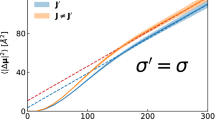Summary
Divergences already appear in the second terms of the expansions of transport quantities obtained either by the Boltzmann-Legendre method or by the mean-free-path method. In the latter it is possible to obtain finite terms by the introduction of an auxiliary termb=za/v, wherev is the electron thermal speed,a=e E/m the electron acceleration andz a dimensionless function to be determined.z is evaluated by comparing the approximate expansions (obtained with the introduction ofb) with the expansions of rigorous solutions which are found in many cases. Sincez only depends on the behaviour forv→0 of the integrands (in the integrals expressing the second terms of the expansions), we can approximate the collision frequencyν, in a small range forv≥0, by ν=αv n where α andn are given parameters. In the one-directional model with one half of the electrons going parallel and one half antiparallel toE, we find that for any transport quantityz depends only onn and we succed in obtainingz(n, μ=0) forn=2 andn=4 only. For the general (or all-directional) case we takez(n)=1/3λz(n, μ=±1)+2/3λz(n, μ=0), where λ is a factor of order unity, since we have one reference axis with μ=±1 and two reference axes with μ=0. BecauseR(n)=z(n)/z(n, μ=±1) forn=2 is not very different fromR(4), we can take forR(n) a linear interpolation betweenR(2) andR(4). Hence we obtainz(n)=λR(n)·z(n, μ=±1) for anyn value. The unknown λ will be determined in a subsequent paper by comparing, in the all-directional case, a rigorous solution (obtainable forn=2) with the corresponding approximate expansion containingz.
Riassunto
Negli sviluppi in serie delle grandezze di trasporto, ottenute sia mediante il metodo di Boltzmann-Legendre sia mediante quello dei liberi cammini, appaiono delle divergenze. Sviluppi con termini finiti possono essere ottenuti col metodo dei liberi cammini introducendo un termine ausiliariob=za/v, dovev è la velocità termica degli elettroni,a=e E/m la loro accelerazione ez una funzione adimensionale che deve essere determinata. Tale determinazione è ottenuta paragonando gli sviluppi approssimati (ottenuti mediante l'introduzione dib) con quelli delle soluzioni rigorose che si possono ottenere in un modello unidirezionale in cui metà degli elettroni iniziano il loro volo in direzione parallela e l'altra metà in direzione antiparallela al campo elettricoE. Ne risulta chez dipende praticamente solo dall'andamento della frequenza di collisione ν(v) perv→0. Si dimostra che un'opportuna modifica dell'espressione trovata può essere applicata anche nel caso tridirezionale dove si riesce a trovare una sola soluzione rigorosa.
Резюме
Расходимости появляются уже во вторых членах разложений траиспортных величин, полученных либо с помощью метода Больцмана-Лежандра, либо с помощъю метода средней длины свободного пробега. В последнем случае оказывается возможным получить конечные члены посредством введения вспомогательного членаb=za/v, гдеv есть тепловая скорость электронов,a=e E/m—ускорение электронов иz есть безразмерная искомая функция.z оценивается с помощъю сравнения приближенных разложений (полученных посредством введенияb) с разложениями строгих решений, которые получены во многих случаях. Так какz зависит только от поведения подынтегральных выражений приv→0 (в интегралах, определяющих вторые члены разложений), мы можем аппроксимировать частоту соударений ν, в малой областиv≥0, выражением ν=αv n, где α иn заданные параметры. В однонаправленной модели, когда половина электронов движется параллельно, а другая половина антипараллельноE, мы находим, что дюбая транспортная величинаz зависит только отn и мы определяемz(n,μ=±1) для любой величиныn (μ=cos θ=v·E/vE). Для электронов, движущихся перпендикулярноE (т.э. μ=0), мы получаемz(n, μ=0) только дляn=2 иn=4. Для общего случая мы принимаемz(n)=1/3λz(n,м=±1)+ 2/3λz(n,μ=0), где λ есть множитель порядка единицы, т.к. мы имеем одну ось отсчета с μ=±1 и две оси отсчета с μ=0.
Similar content being viewed by others
References
G. Cavalleri, E. Gatti andF. Gonzalez-Gascon:Nuovo Cimento B,55, 291 (1980).
G. Cavalleri:Nuovo Cimento B,55, 360 (1980).
G. Cavalleri andR. Bonalumi:Nuovo Cimento B,55, 318 (1980).
See, for example,F. V. Dwight:Tables of Integrals and Other Mathematical Data, 4th edition (New York, N. Y., 1961), p. 230.
SeeHandbook of Mathematical Functions, edited byM. Abramowitz andI. A. Stegun (New York, N. Y., 1970), p. 298, 7.1.23.
Author information
Authors and Affiliations
Additional information
Переведено редакцией.
Rights and permissions
About this article
Cite this article
Cavalleri, G., Di Lascio, R. & Giuntoli, V. Evaluation of the auxiliary termb introduced for making the expansions of transport quantities convergent. Nuov Cim B 55, 329–359 (1980). https://doi.org/10.1007/BF02739165
Received:
Published:
Issue Date:
DOI: https://doi.org/10.1007/BF02739165




